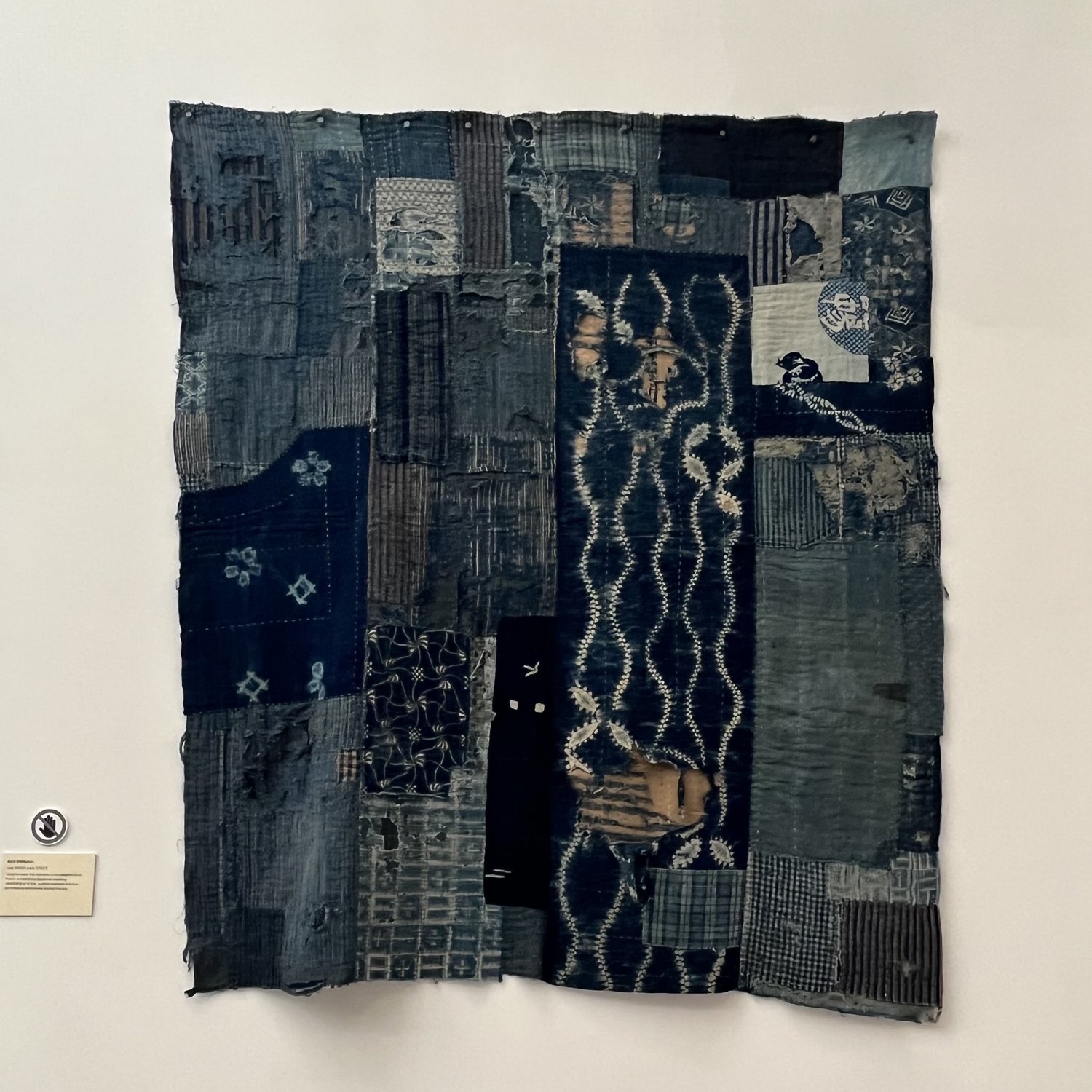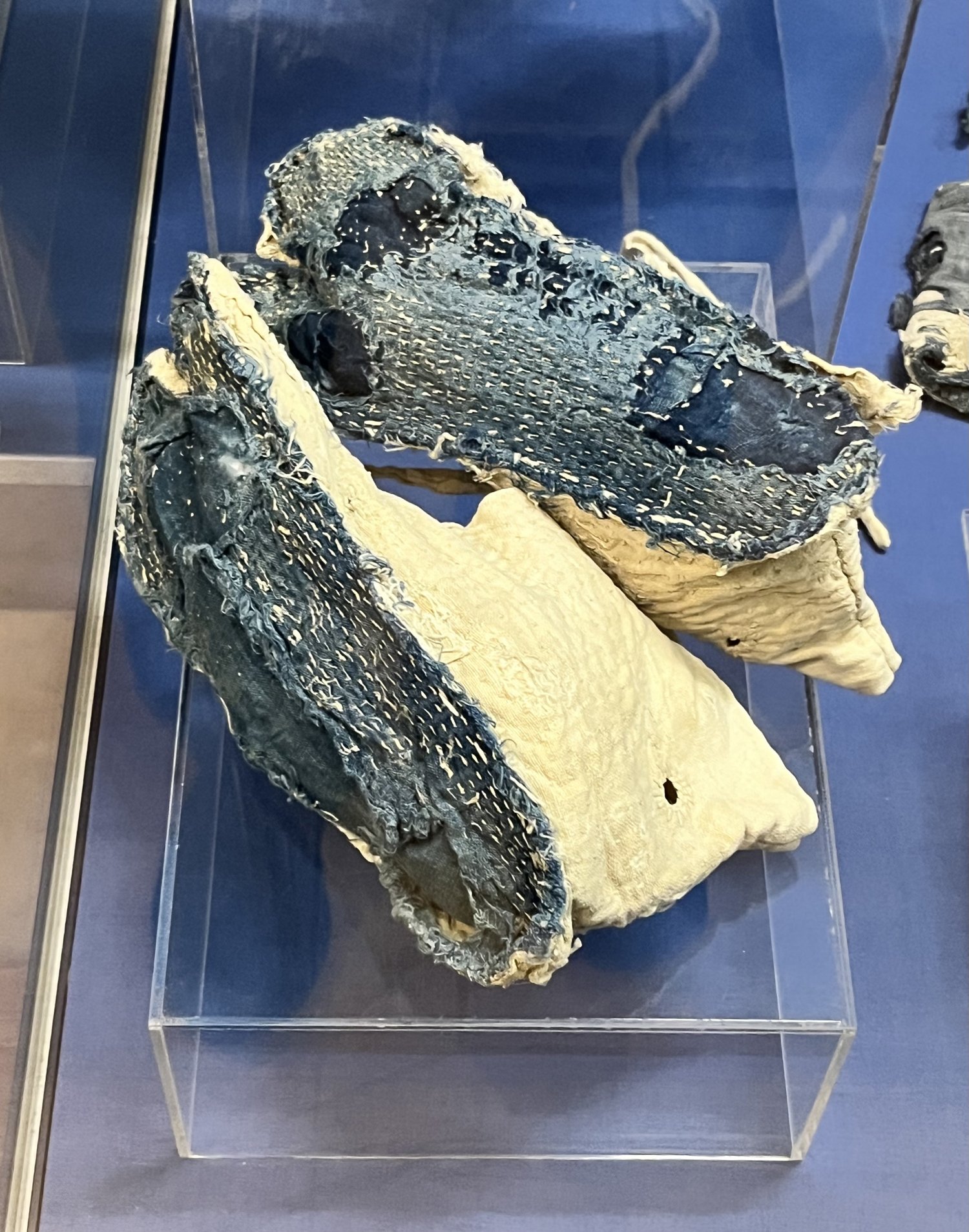From 13th July through 23rd September 2023 the Brunei Gallery at SOAS University of London is exhibiting over 100 objects from the Karun Thakar Collection. These mostly date from the Edo period (1603 - 1868) and include many Boro textiles, Kintsugi and Ginsugi (pottery mended with gold or silver) and Washi handmade paper, which was used as wrappings for valuable kimono and documents.
The exhibition is free to attend. Nearest tube: Russell Square.
Open Tuesday through Saturday 10.30 - 17.00, Thursday late until 20.00
Brunei Gallery, SOAS University of London, Thornhaugh Street, Russell Square, London, WC1H 0XG
Read on for pictures from the exhibition and some commentary from me. I’ve only posted about the Boro textiles here but the Kintsugi and Washi paper exhibits are also very interesting and there’s so much more to see at the exhibition than the few pieces I’ve shown here!
Large Boro quilt - the back of the piece has been presented as this is the interesting side where you can see how the patches were joined and the stitching. The front is often as uniform a blue as possible with tiny stitches to hide the fact it had been made from scraps.
I have long been fascinated by all things Japanese and there’s one thing that really says Japanese textiles to me and that’s Boro.
Boro or more accurately “boro boro” means rags and tatters in Japanese and is the name given to the clothing and bedding made by the very poorest farming folk in Japan who could not afford to buy new fabric of any kind. Everything was made from scraps salvaged and saved from wherever they could be found and then repaired and patched for generations.
The fabrics have a strange beauty and it would be fascinating to understand their creation and journey alongside the lives of their makers.
Occasionally several families would club together their limited resources to get hold of a bale of soiled scrap fabrics collected from the streets of the big cities. These would often be filthy and would need to be soaked in lye overnight and the dirt scraped off with leaves and twigs. The fabrics would then be rinsed in cold water and this process was sometimes repeated several times before the scraps would be fit to use.
Checked and striped fabrics are common in Boro pieces alongside indigo dyed pieces. Indigo was a much used and understood dye in Japan and readily available. Hand loomed fabrics would be sewn alongside machine made ones, even using scraps of old Tenugi wash cloths was common.
The people who made Boro pieces couldn’t afford to be picky and save “better” pieces like Katazome (stencil dyed work). Although Katazome pieces would originally have been made by skilled craftspeople, they were still just seen as patch fabric to fill a gap. Katazome involves using finely cut paper stencils with a special rice paste to create resist patterns on fabric when dyed in indigo. If you’d like to try it yourself click on the button below.
Shibori (resist dyed using stitching and binding) pieces were also used in Boro pieces. Again made by skilled craftspeople, the fabrics were just another source of patch material. Shibori itself has a rich history in Japan spanning 1500 years and the potential patterns it can create are endless. If you’d like to try it yourself, come and join me at one of my Shibori classes online or in person. In person classes include indigo dyeing at my studio in Muswell Hill.
Bedding would be made by sewing together several layers of fabric for warmth. If a garment or bedding got a hole in it, it would just be patched over with another piece of fabric, whatever was available.
People often ask me how old a piece of Boro is, and it’s very difficult to say as individual parts of it could be from the 1700s and also from the 20th century as new (which could still be old!) pieces were added many times in the life of a fabric.
A collection of Boro kimono and jackets
Clothing was also commonly made from patches, often with densely stitched areas (Nami nui) where rows and rows of running stitch were sewn across the piece. This added strength and durability and also warmth.
This piece is made up of patches of woven Kasuri. Kasuri (think Japanese IKAT) is made up from warp and weft threads that have been precisely space dyed using binding thread as a resist to make a planned pattern and woven on a loom. Skeins of thread would typically be dipped 30 times in the indigo to achieve very dark, almost black indigo colour. The creation of Kasuri fabrics is a highly technical and time-consuming process but these fabrics still ended ups as Boro patches…
This is a child’s kimono made up of Katazome stencilled fabric and Shima (striped) fabric.
Japanese Boro tabi (shoes). Tabi literally means “foot bag” and these shoes had a separate big toe and are characteristic of Japanese footwear of the time, although you can still get socks like this in Japan today.
Komebukuro rice bags made from Kasuri fabrics. These were often held together using handmade Kumihimo braids. Read my Journal post on Kumihimo for more information.
We obviously can’t make Boro textiles today as we aren’t desperately poor Japanese farmers but, if you’d like to take inspiration from my vintage Boro pieces to do some mending on your own clothes, please join me for either an online Zoom class or in person at my studio in Muswell Hill or elsewhere.
And I also sell a kit with instructions on how to make your own Boro inspired tote bag containing vintage patches, Sashiko needle and thread a cotton tote bag.








